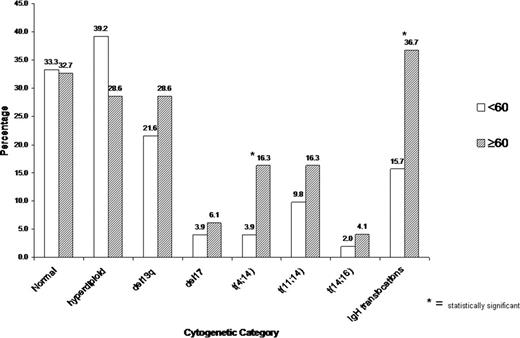Abstract
Abstract 1913
Molecular cytogenetic evaluation of chromosome abnormalities has proven to be an important tool to determine prognosis in newly diagnosed multiple myeloma (MM) patients. The majority of MM patients will have one or more cytogenetic abnormality detectable by fluorescence in situ hybridization (FISH). Deletion of 17p13, t(4;14)(p16;q32) and t(14;16)(q23;q32) define high-risk MM, while abnormalities common in standard risk MM are hyperdiploid karyotype and t(11;14)(q13;q32). The prognostic importance of deletion of 13q14 detected by FISH is controversial with worse outcome noted in some but not all series. Even though a strong correlation between age and patter of chromosome abnormalities has been demonstrated in other hematologic malignancies (e.g. acute leukemias), such association has not been clearly defined in MM. We utilized a cohort with high frequency of young patients to further explore the correlation between FISH abnormalities and age in MM.
This is a retrospective analysis of all patients seen at our institution with diagnosis of MM from 2002 to 2010 and for whom comprehensive FISH analysis of MM cells was available. Patients were divided in two groups according to age. The proportions of specific FISH findings were compared between the two groups using chi-square test.
One hundred patients were identified with a median age of 59 years (range 20–81). We defined two groups containing younger (age < 60 years, N=51) and older patients (age ≥ 60 years, N=49). FISH abnormalities were detected in 66% (99%C.I. 56.7–75.3%) of patients. Older MM patients had a significantly higher incidence of l t(4:14) abnormalities (16.3% vs 3.9% p=0.039) and IgH rearrangements in general (36.7% vs 15.7% p=0.02). There were no significant differences between the two groups for the frequency of any of the remaining FISH abnormalities (see Figure). Similarly, no pattern of association was seen between FISH panel and initial International Staging System.
Even though there does not seem to be a strong association between age and MM FISH abnormalities, our findings suggest a higher frequency of translocations involving IgH, particularly t(4;14), among older patients. It is unlikely however that the differences in outcomes between younger and older MM patients are due to intrinsic biological differences.
No relevant conflicts of interest to declare.
Author notes
Asterisk with author names denotes non-ASH members.


This feature is available to Subscribers Only
Sign In or Create an Account Close Modal